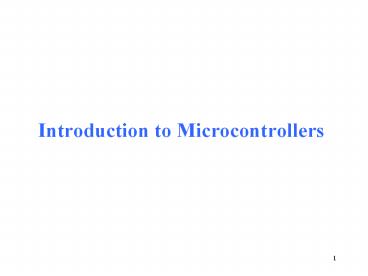Introduction to Microcontrollers PowerPoint PPT Presentation
1 / 9
Title: Introduction to Microcontrollers
1
Introduction to Microcontrollers
2
Early Microcontrollers
- 1974 Motorola (originally car radio
manufacturers) had introduced transistors in the
1950s and decided to make a late but serious
effort in the microprocessor market. They
announced their 8-bit 6800 processor. Though
bulky, and fraught with production problems,
their 6800 had a good design. - 1975 General Motors approach Motorola about a
custom-built derivative of the 6800. Motorola's
long experience with automobile manufacturers
pays off and Ford follow GM's lead. - 1976 Intel introduce an 8-bit microcontroller,
the MCS-48. They ship 251,000 in this year. - 1980 Intel introduce the 8051, an 8-bit
microcontroller with on-board EPROM memory. They
ship 22 million and 91 million in 1983.
3
Microcontroller
- Essentially a microprocessor with on-chip
memories and I/O devices - Designed for specific functions
- All in one solution - Reduction in chip count
- Reduced cost, power, physical size, etc.
- Examples
- MC68332, MC68HC11, PPC555
- Components
- - A/D converters, temperature sensors,
communications, timing circuits, many others
4
History of Microprocessors
- 1950s - The beginning of the digital era and
electronic computing - 1969 Intel is a small startup company in Santa
Clara with 12 employees - Fairchild, Motorola are large semiconductor
companies HP and Busicom make calculators - 1971 Intel makes first microprocessor the 4-bit
4004 series for Busicom calculators - 1972 Intel makes the 8008 series, an 8-bit
microprocessor, - ATARI is a startup company
- Creates a gaming console and releases PONG
5
History of Microprocessors
- 1974 the first real useful 8-bit microprocessor
is released by Intel the 8080 - Motorola introduces the 6800 series
- Zilog has the Z80
- 1975 GM and Ford begin to put microcontrollers
in cars - Many cars today have over 100 microcontrollers
- TI gets into the microprocessor business with
calculators and digital watches - 1977 Apple II is released using MOS 6502
(similar to motorola 6800). Apple II dominated
from 1977 to 1983 - 1978 Intel introduces the first 16-bit
processor, the 8086 - Motorola follows with the 68000 which is
ultimately used in the first Apple Macintosh
6
History of Microprocessors
- 1981 IBM enters the PC making market and uses
the Intel 8088 proliferation of the home
computer - 1982-1985 Intel introduces the 32-bit 80286 and
80386 - 1989 80486 is being used in PCs, able to run
Microsoft Windows - 1992 Apple, IBM and Motorola begin to make
PowerMac and PowerPCs using Motorola chips - 1993 Pentium chip is released
- The rest is history
7
Components of a Computer
- Central Processing Unit
- Interprets and carries out all the instructions
contained in software - Memory
- Used to store instructions and data
- Random Access Memory (RAM)
- Read Only Memory (ROM)
- Input/Output
- Used to communicate with the outside world
8
Microprocessor
- A single chip that contains a whole CPU
- Has the ability to fetch and execute instructions
stored in memory - Has the ability to access external memory,
external I/O and other peripherals - Examples
- Intel P4 or AMD Athlon in desktops/notebooks
- ARM processor in Apple iPod
9
Embedded System
- Special purpose computer system usually
completely inside the device it controls - Has specific requirements and performs
pre-defined tasks - Cost reduction compared to general purpose
processor - Different design criteria
- Performance
- Reliability
- Availability
- Safety

